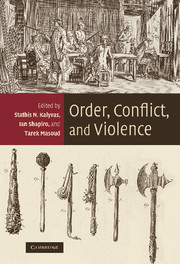Book contents
- Frontmatter
- Contents
- List of figures
- List of tables
- List of contributors
- Preface
- 1 Introduction: integrating the study of order, conflict, and violence
- Part 1 Creating, maintaining, and restoring order
- 2 Probing the sources of political order
- 3 Attaining social order in Iraq
- 4 Factors impeding the effectiveness of partition in South Asia and the Palestine Mandate
- 5 The social order of violence in Chicago and Stockholm neighborhoods: a comparative inquiry
- 6 Traditions of justice in war: the modern debate in historical perspective
- 7 Problems and prospects for democratic settlements: South Africa as a model for the Middle East and Northern Ireland?
- Part 2 Challenging, transforming, and destroying order
- Index
- References
4 - Factors impeding the effectiveness of partition in South Asia and the Palestine Mandate
Published online by Cambridge University Press: 06 July 2010
- Frontmatter
- Contents
- List of figures
- List of tables
- List of contributors
- Preface
- 1 Introduction: integrating the study of order, conflict, and violence
- Part 1 Creating, maintaining, and restoring order
- 2 Probing the sources of political order
- 3 Attaining social order in Iraq
- 4 Factors impeding the effectiveness of partition in South Asia and the Palestine Mandate
- 5 The social order of violence in Chicago and Stockholm neighborhoods: a comparative inquiry
- 6 Traditions of justice in war: the modern debate in historical perspective
- 7 Problems and prospects for democratic settlements: South Africa as a model for the Middle East and Northern Ireland?
- Part 2 Challenging, transforming, and destroying order
- Index
- References
Summary
Introduction
Contemporary international affairs are imbued with the legacy of partition. Conflict has continued for decades in partitioned areas as diverse as the Korean peninsula, South Asia, and Ireland, demonstrating that partition is not the straightforward solution to ethnic or religious conflict that it may seem. To divide warring parties may appear simple in conception, but implementing an effective partition – one that contributes to conflict resolution and minimizes violence – is dauntingly complex. Members of the international community, and the United States in particular, expend enormous resources on these problems. They maintain a military presence, as the United States does in South Korea, and Britain in Northern Ireland; they invest in repeated attempts at peacemaking, as in the Middle East; or they suffer the consequences, often global in impact, of failing to keep the peace. The utility of partition, as well as its long-term repercussions, are therefore issues of great significance to international security.
This essay seeks to aid decision-makers considering partition as a solution to violent conflict by exploring two contrasting cases from British imperial history: the Palestine Mandate, where the British discussed various partition plans at great length, but ultimately refused to implement a division, and South Asia, where the British resisted any discussion of partition, then implemented a division hastily. My comparative analysis of these two cases, which in many ways are very different, reveals four crucial common factors:
(a) a population made up of intermingled religious, ethnic, or other groups;
(b) militarization of competing factions within the civilian population;
[…]
- Type
- Chapter
- Information
- Order, Conflict, and Violence , pp. 75 - 96Publisher: Cambridge University PressPrint publication year: 2008
References
- 2
- Cited by



